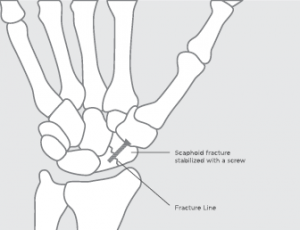WRIST FRACTURES, HAND FRACTURES, AND FINGER FRACTURE
INTRODUCTION
One of the more common bones to break around the wrist is the scaphoid (sometimes called the navicular). The scaphoid is one of the first bones of the base of the hand (carpal bones) and sits on the end of one of the two forearm bones called the radius. Its location between the forearm and the hand combined with its narrow-waisted, peanut shape make it particularly vulnerable to breaking when the wrist is forcibly bent back. It is a common injury in sports (like football) but can be broken anytime a person falls onto an outstretched hand.
The main symptoms of a scaphoid fracture are pain and swelling around the wrist. People often think that if they can still move their wrist after an injury that no bones are broken. This is not the case with scaphoids. Scaphoid fractures are often diagnosed late due to the fact that the pain is not always severe, the swelling is not dramatic, and the bruising is often minimal or absent. If there is anything to suggest a serious injury, the wrist should be evaluated by a qualified health care professional including the use of x-ray to examine the bone. Even x-rays are not 100% accurate in revealing the fracture, especially in the first week of injury. For that reason, repeat x-rays (and occasionally an MRI or CT scan) are often obtained 7-10 days after the injury in suspicious cases.
TREATMENT
The initial treatment in known or suspected fractures is immobilization with a splint, elevation to reduce swelling, and ice for comfort if necessary. An evaluation by a hand surgeon is preferably done within 7-10 days of the initial injury. The treatment can then be tailored to the specific pattern, location and severity of the break. The majority of scaphoid fractures can be treated with immobilization alone, typically in a fiberglass cast for 6-12 weeks. This is often followed by the use of a removable brace to allow motion exercises. Therapy is sometimes required to regain motion and strength.
In certain cases, especially when the pieces of the bone are clearly separated, surgery is considered. This typically involves realigning the broken ends of the bone and holding them together using a metal implant such as a screw. This can be done safely in an outpatient setting.

